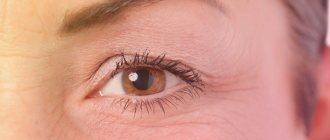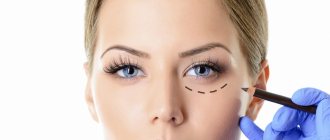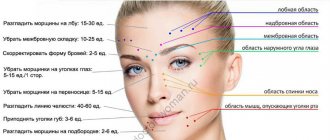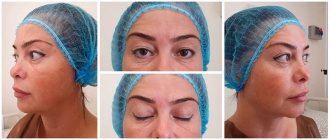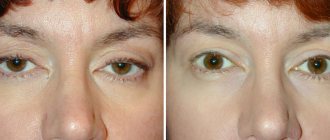Why does the upper eyelid droop after Botox?
There are two reasons why ptosis of the upper eyelid appears after Botox:
In this article
- Why does the upper eyelid droop after Botox?
- Who is to blame for the occurrence of ptosis after Botox?
- Ptosis: symptoms and classification
- What are the consequences of ptosis of the upper eyelid?
- Treatment of eyelid ptosis after Botox
- How to prevent upper eyelid ptosis
- Decreased or loss of muscle tone: this can cause drooping of not only the eyelid, but also the eyebrows, so the asymmetry of the face will be much greater.
- Severe swelling of the tissues of the eyelids and forehead: muscle fibers are paralyzed due to botulinum toxin, as a result of which the outflow of lymph and venous blood becomes worse. Therefore, fluid accumulates in the tissues and pulls the eyelids down.
Treatment of ptosis of the upper eyelid after Botox (or Dysport) should be based precisely on the cause of its occurrence. It will not be possible to solve the problem without a qualified specialist. You should not try to get rid of the defect using self-selected treatment products. This will only make the situation worse.
How to get rid of wrinkles and lift eyelids without Botox
The surest way to transform the eye area is a properly selected set of exercises. MelAnnett has been developing a program for natural rejuvenation of the body for several years and testing it in practice. As a result, the “Basic Marathon” was created. This is a set of exercises that straightens the back, relieves muscle tension, improves blood supply and lymphatic drainage, that is, it solves the main problems that provoke age-related changes. At the end of the marathon, each wrinkle is polished separately.
Among other results, MelAnnett's Basic Marathon helps eliminate crow's feet and lift eyelids.
If you've already had Botox and are unhappy with the effect, don't let yourself down! Get started on your recovery by taking part in the Basic Marathon!
Who is to blame for the occurrence of ptosis after Botox?
Of course, all responsibility for the quality of the procedure lies with the specialist. But it’s not always a matter of his lack of professionalism. The following factors can lead to the appearance of the conditions described above:
- Individual intolerance to the administered drug. It occurs especially often if Botox (Dysport) is administered frequently. However, after the first procedures everything is usually fine. The “critical mass” of the drug is achieved in 8-10 sessions, which are performed over a period of approximately 3-4 years. Between procedures you need to take breaks, during which time muscle mobility will be completely restored. If, after the next procedure, cosmetologists notice that the forehead, eyelids or eyebrows have “dropped”, the amount of the drug is reduced and the area of its administration is narrowed.
- High dosage of the drug. In this case, the occurrence of ptosis after Botox is caused by careless injections or the use of large amounts of botulinum toxin. There are many options for administering the drug, and all of them have the right to life, however, increasing the amount of the substance increases the risk of complications. +
- Some inexperienced cosmetologists often administer drugs according to a universal scheme. One of the most dangerous points used for Botox injection is located 1 cm from the inner edge of the eyebrow. Each person's eyebrows are positioned differently, sometimes they are at the level of the edge of the eye socket. Therefore, if these features are not taken into account, Botox often “turns off” the frontalis muscle or some part of the eye muscle.
- Features of injection distribution: after an injection, the drug molecules “move” slightly further from the injection points. The likelihood of upper eyelid muscle paralysis depends on diffusion: the higher it is, the greater the risks. All drugs have their own distance - this fact must be taken into account by the cosmetologist.
How to deal with the consequences of botulinum toxin injections
The most common complication is a bump after a Botox injection. Sometimes it occurs so quickly that the patient does not have time to leave the cosmetologist’s office. However, do not rush to blame the specialist: it is extremely difficult to predict the body’s reaction to the drug, so professionals administer Botox in small portions so that the consequences can be quickly corrected.
If the Botox bump lasts 7-14 days, then it is recommended to make additional injections to relax the muscles. If this does not help, they resort to physical therapy, administration of a DMAE cocktail or injections of an enzyme preparation.
If you want to do without injections , an excellent alternative is the introduction of absorbable substances using microcurrents, electrophoresis or ultrasound.
Ptosis: symptoms and classification
It is quite difficult not to notice the development of ptosis after Botox: the upper eyelid noticeably droops, causing the palpebral fissure to become much smaller. The speed at which the defect develops varies: usually ptosis appears already on the 2nd day after the injection, but in some cases this can happen a week or two later.
There are several types of ptosis of the upper eyelid after Botox:
By location they are distinguished:
- unilateral - develops only in one eye and occurs most often;
- bilateral - appears on the eyelids of both eyes.
By severity:
- partial - the eyeball is covered by the eyelid up to the upper third of the pupil;
- incomplete - half of the pupil is closed with the eyelid;
- full - the pupil is completely closed by the eyelid.
Regardless of the type, drooping of the upper eyelid significantly impairs the quality of life and appearance, so it is important to know what to do to treat it and restore the functionality of the muscles affected by Botox injections.
Duration of swelling
Are your lips swollen after lip augmentation, and would you like to know how long this effect will last? It all depends on the drug used by the cosmetologist, its volume, the number of injections and the individual characteristics of the body. Fillers containing low molecular weight hyaluronic acid cause minimal side effects and complications; more concentrated gels often provoke severe swelling. Normally, swelling lasts no more than 14 days and goes away without outside intervention. If the reaction is strong, the condition bothers you, or lasts longer than expected, seek help from a cosmetologist. The key to successful results of the procedure is the correct choice of specialist and the use of high-quality drugs.
What are the consequences of ptosis of the upper eyelid?
Drooping of the eyelid as a result of an unsuccessful Botox injection is accompanied by unpleasant symptoms. Among them:
- Pronounced facial asymmetry, resulting from significantly different sizes of the palpebral fissures. In addition to the eyelid, sometimes one of the eyebrows droops, which makes the asymmetry even more noticeable.
- Problems with cleaning and moistening the eyeball, resulting from the inability to blink. In some cases, this causes chronic eye irritation.
- Difficulty trying to close the eyes completely, caused by loss of muscle control. Because of this, the visual organs are in constant tension, quickly get tired, and heaviness is felt in the frontal region. To look at objects, you have to tilt your head back, this provokes poor circulation and headaches.
- Problems with the drainage of tear fluid, causing tears to constantly flow from the eye.
If not only the lifting eyelid muscles are damaged, but also the oculomotor muscles, then, in addition to eyelid ptosis, strabismus and decreased visual acuity may occur.
All of these side effects are rare. However, even one of them is enough to worsen the quality of life and increase the level of discomfort.
Treatment of eyelid ptosis after Botox
To begin with, we note that it is possible to remove ptosis after Botox. In many cases, the eyelid begins to function approximately 3 weeks after the injection. However, all this is individual; sometimes drooping (ptosis) of the upper eyelid goes away after six months, when the effect of the administered drug stops.
Doctors can still speed up this process and improve the patient's appearance while the muscles are still paralyzed. Treatment of ptosis is carried out using the following methods:
- Administration of another additional dose of the drug. This is necessary to lower the “non-functioning” eyelid and helps balance the strength of the muscles, causing it to begin to function. For mild ptosis, an injection is given into the muscles that raise the eyebrow above the opposite eye. This helps to lower it a little and even out the asymmetry.
- The introduction of drugs that help restore the functionality of damaged muscles and strengthen the fibers located next to them. Such drugs are quite effective, but you should not expect that they will immediately cure ptosis. This method can only be used as one part of therapy.
- Myostimulation/microcurrents are physiotherapeutic methods that help restore muscle tone. It will be quite expensive, but it will have an effect. Massages also significantly speed up the healing process; you can do them yourself, kneading the damaged eyelid with your fingertips.
Asymmetry cannot be treated with surgery. If the treatment methods described above do not give the desired result, all that remains is to wait until the effect of the drug wears off and muscle function recovers on its own.
There is no effect from the administration of Dysport.
Causes:
- resistance to botulinum toxin type A. This group includes patients with a history of tetanus or other cross-diseases, as well as genetic insensitivity to this group of drugs. Further actions: increase the dose. If the effect is not achieved, then use other correction methods.
- antibiotic therapy during the botulinum therapy procedure. Further actions: repeat the procedure two weeks after antibiotic therapy.
- Resistance due to frequent injections or small doses You should not inject Dysport more than once every 4-6 months. When small doses are administered, a vaccination effect and “addiction” to the drug occurs. Further actions: you can do the procedure 6 months later, at least after complete restoration of facial activity.
How to prevent upper eyelid ptosis
No one can be immune from ptosis of the upper eyelid after a beauty injection. However, you can reduce this risk by following simple rules:
- You should only contact specialists who have been working with botulinum toxin for many years. This will minimize the number of errors associated with technique and dosage, and if a complication occurs, it can be quickly and safely eliminated.
- If minor neurological symptoms occur, the procedure should not be performed: due to overstrain, the muscles may react in an unpredictable way.
- Follow all recommendations for facial care after Botox injection: many of them are aimed specifically at preventing drooping eyelids.
What needs to be done when eyelid ptosis does appear after Botox? Contact another specialist with extensive experience, tell him in detail about the drooping eyelid and the procedure. Then he will use a different dosage of the drug and will be more attentive during the work process.
Why is it dangerous?
Most women believe that swelling under the eyes is a purely aesthetic problem. Yes, they look unattractive, but they cannot cause harm to the body. Alas, in reality it is not so simple. Severe swelling indicates that lymph flow and normal blood circulation are disrupted. He can:
- provoke drying of the mucous membrane;
- cause conjunctivitis;
- lead to excessive lacrimation.
If capillary circulation is severely impaired and is not restored within 1-2 days, there is a danger of developing soft tissue necrosis. Therefore, long-lasting swelling should never be ignored.
It is necessary to consult a doctor immediately if the swelling is accompanied by soreness of the skin when touched, severe redness, increased body temperature, and inability to open the eyes. Most likely, you will need hardware or drug treatment, which will neutralize the result of the procedure.
